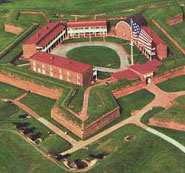















Successes in Stewardship: March 2008 |
|---|

|
Federal Highway Administration
March 2008
Section 4(f) Final Rule: New Guidance on a Complex Regulation

Section 4(f), the statute that protects public parks, recreational areas, wildlife and waterfowl refuges, and public and private historical sites from use by proposed transportation projects, is one of the most stringent environmental laws related to transportation. Its requirements involve judgments that elude easy explanation and are often difficult to interpret with a great deal of confidence. As a result, Section 4(f) has become the most frequently litigated environmental statute in the Federal Highway Program aside from the National Environmental Policy Act (NEPA). It is also the most frequent cause of court injunctions delaying highway projects.1 If Section 4(f) compliance becomes an issue during the preparation of an Environmental Impact Statement (EIS), project approval can take additional time.
On March 12, 2008, the Federal Highway Administration (FHWA) and Federal Transit Administration (FTA) published a Section 4(f) Final Rule in the Federal Register to help clarify the 4(f) approval process and simplify its regulatory requirements. This month's newsletter provides a first look at the Final Rule, highlighting key changes made to the 4(f) regulation as required by Section 6009 of the Safe, Accountable, Flexible, Efficient Transportation Equity Act: A Legacy for Users (SAFETEA-LU).
Established in the U.S. Department of Transportation Act of 1966, Section 4(f) was designed to protect publicly owned parks, recreational areas, wildlife and waterfowl refuges, and public and private historical sites from use by transportation projects unless the Administration determines that there is no "feasible and prudent" avoidance alternative and that all possible planning to minimize harm" has occurred. Section 4(f) originated during the peak period of Federal highway construction with the goal of preserving urban parks and historical sites that were in jeopardy of being destroyed.
Early case law strictly interpreted what qualified as a "feasible and prudent" avoidance alternative. In its 1971 Overton Park decision2 , the U.S. Supreme Court articulated a very high standard for compliance with Section 4(f). In the years that followed, however, courts applied the Overton Park ruling differently in similar situations, reaching diverse conclusions about the extent to which certain mitigating factors may be considered in determining whether or not an avoidance alternative is "feasible and prudent."
Two important changes to the Section 4(f) process occurred in 2005 in connection with Section 6009 of SAFETEA-LU. First, the process for approving projects that will have de minimis impacts on property protected by Section 4(f) was simplified. The analysis of avoidance alternatives is no longer required when a transportation use of a Section 4(f) property is determined to have a de minimis impact. Second, the Secretary of Transportation was directed to clarify which factors to consider and which standards to apply for determining the "prudence and feasibility" of alternatives that avoid the use of Section 4(f) property.
In response to SAFETEA-LU's directive, FHWA and FTA published a Notice of Proposed Rulemaking (NPRM) containing modifications to the existing 4(f) regulations on July 27, 2006. The NPRM received 37 responses from state and regional transportation agencies, trade associations, national and environmental advocacy groups, Federal agencies, a state historical preservation officer, and two members of the public. After carefully considering all of the submitted comments, FHWA and FTA published their Final Rule, Title 23 of the Code of Federal Regulations (CFR), Part 774: Parks, Recreation Areas, Wildlife and Waterfowl Refuges, and Historic Sites (Section 4(f)), in the Federal Register on March 12, 2008. The new rule will govern all 4(f) approvals granted as of the effective date.
| 774.1 | Purpose |
| 774.3 | Section 4(f) Approvals |
| 774.5 | Coordination |
| 774.7 | Documentation |
| 774.9 | Timing |
| 774.11 | Applicability |
| 774.13 | Exceptions |
| 774.15 | Constructive Use Determinations |
| 774.17 | Definitions |
While Section 4(f) remains codified in law at Title 49 United States Code (USC) § 303 and 23 USC § 138, the regulation implementing this law has been moved from 23 CFR 771, FHWA's NEPA implementation regulation, to 23 CFR 774, in order to highlight that Section 4(f) is one of numerous social, economic, and environmental issues that must be considered under the "umbrella" of the environmental review process. In addition to being assigned a new location, the regulation has been reorganized to improve clarity and readability (see sidebar).
While a number of sections, such as "Timing" and "Constructive Use Determinations," remain largely unchanged, the Final Rule makes five principal changes to the Section 4(f) regulation:The Final Rule will take effect on April 11, 2008.
Sources
1 http://www.section4f.com/case_studies.htm
2 For more information on the Overton Park case, visit http://www.section4f.com/case_overton.htm.
|
Lamar Smith, CEP Federal Highway Administration Office of Project Development and Environmental Review 1200 New Jersey Avenue, SE Washington, DC 20590 202-366-8994 Lamar.Smith@dot.gov Joseph Ossi Federal Transit Administration Office of Planning and Environment 1200 New Jersey Avenue, SE Washington, DC 20590 202-366-1613 Joseph.Ossi@dot.gov |
Look What's New!ACHP ONLINE COURSE FREE UNTIL APRIL 30th - For a limited time, ACHP is offering the course "working effectively with Tribal Governments" for free. You can access it at www.GoLearn.gov (click on the thumbnail to go to tribal training). The course takes about an hour to complete, and includes modules on tribal concepts, Federal Indian law and policy, and cultural orientation. TELL US WHAT YOU THINK - Do you have a newsletter topic you'd like to read about? Are the newsletters helpful? Your feedback is wanted! Please send any comments or questions to esnewsletter@volpe.dot.gov. |
|
|
